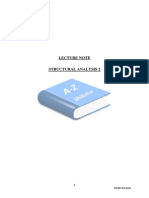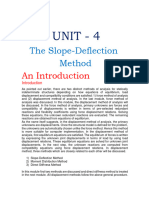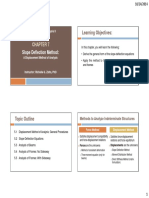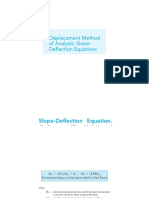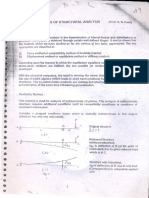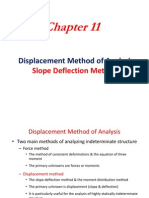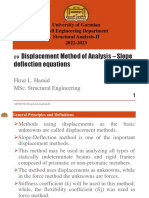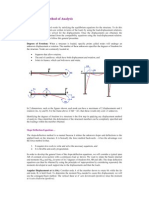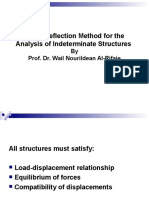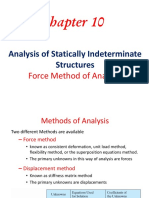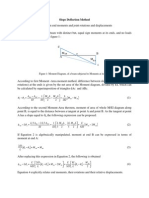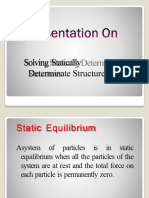0% found this document useful (0 votes)
155 views36 pagesSlope Deflection Method
Metodo de Pendiente-Deformacion para marcos planos
Uploaded by
David OrtizCopyright
© © All Rights Reserved
We take content rights seriously. If you suspect this is your content, claim it here.
Available Formats
Download as PDF or read online on Scribd
0% found this document useful (0 votes)
155 views36 pagesSlope Deflection Method
Metodo de Pendiente-Deformacion para marcos planos
Uploaded by
David OrtizCopyright
© © All Rights Reserved
We take content rights seriously. If you suspect this is your content, claim it here.
Available Formats
Download as PDF or read online on Scribd
/ 36
cates ha
The members of this building frame are all fixed connected, so the framework
is statically indeterminate.
Displacement Method
of Analysis: Slope-
Deflection Equations
In this chapter we will briefly outline the basic ideas for analyzing
structures using the displacement method of analysis. Once these
concepts have been presented, we will develop the general equations
of slope deflection and then use them to analyze statically indetermi-
nate beams and frames
11.1 Displacement Method of Analysi
General Procedures
All structures must satisly equilibrium, load-displacement, and
compatibility of displacements requirements in order to ensure their
safety. It was stated in Sec, 10-1 that there are two different ways to
satisfy these requirements when analyzing a statically indeterminate
structure, The force method of analysis, discussed in the previous chapter,
is based on identifying the unknown redundant forces and then satisfying
the structure's compatibility equations. This is done by expressing the
displacements in terms of the loads by using the load-displacement
relations, The solution of the resultant equations yields the redundant
reactions, and then the equilibrium equations are used to determine the
remaining reactions on the structure.
The displacement method works the opposite way. It first requires
satisfying equilibrium equations for the structure. To do this the
unknown displacements are written in terms of the loads by using
the load-displacement relations, then these equations are solved for the
displacements. Once the displacements are obtained, the unknown
loads are determined from the compatibility equations using the
load-displacement relations. Every displacement method follows this
451
452 CHAPTER 11 DISPLACEMENT METHOD OF ANALYSIS: SLOPE-DEFLECTION EQUATIONS
general procedure. In this chapter, the procedure will be generalized
to produce the slope-deflection equations. In Chapter 12, the
moment-distribution method will be developed. This method sidesteps
the calculation of the displacements and instead makes it possible to
apply a series of converging corrections that allow direct calculation of
the end moments. Finally, in Chapters 14, 15, and 16, we will illustrate
how to apply this method using matrix analysis, making it suitable for
use on a computer.
In the discussion that follows we will show how to identify the unknown
displacements in a structure and we will develop some of the important
load-displacement relations for beam and frame members. The results
will be used in the next section and in later chapters as the basis for
applying the displacement method of analysis.
Degrees of Freedom. When a structure is loaded, specified
points on it, called nodes, will undergo unknown displacements. These
displacements are referred to as the degrees of freedom for the structure,
and in the displacement method of analysis it is important to specify
these degrees of freedom since they become the unknowns when the
method is applied. The number of these unknowns is referred to as the
degree in which the structure is kinematically indeterminate,
To determine the kinematic indeterminacy we can imagine the
structure to consist of a series of members connected to nodes, which
are usually located at joints, supports, at the ends of a member, or where
the members have a sudden change in cross section. In three dimensions,
cach node on a frame or beam can have at most three linear displacements
and three rotational displacements; and in two dimensions, each node can
have at most two linear displacements and one rotational displacement.
Furthermore, nodal displacements may be restricted by the supports, or
due to assumptions based on the behavior of the structure, For example, if
the structure is a beam and only deformation due to bending is considered,
then there can be no linear displacement along the axis of the beam since
this displacement is caused by axial-force deformation,
To clarify these concepts we will consider some examples, beginning
with the beam in Fig. 11-1a. Here any load P applied to the beam will
cause node A only to rotate (neglecting axial deformation), while node B
is completely restricted from moving. Hence the beam has only one
unknown degree of freedom, #4, and is therefore kinematically indeter-
minate to the first degree. The beam in Fig. 11-1b has nodes at A, B, and
and so has four degrees of freedom, designated by the rotational
displacements 04, 0g, 0c, and the vertical displacement Ac. It is kinemat-
ically indeterminate to the fourth degree. Consider now the frame in
Fig. Li-Le. Again, if we neglect axial deformation of the members, an
arbitrary loading P applied to the frame can cause nodes B and C to
rotate, and these nodes can be displaced horizontally by an equal
amount. The frame therefore has three degrees of freedom, 0g, Oc. As,
Fig. 11-1 and thus it is kinematically indeterminate to the third degree.
11.2 SLoPe-DeFtrcrioN Eauarions
In summary, specifying the kinematic indeterminacy or the number of
unconstrained degrees of freedom for the structure is a necessary first step
when applying a displacement method of analysis. It identifies the number
of unknowns in the problem, based on the assumptions made regarding
the deformation behavior of the structure, Furthermore, once these nodal
displacements are known, the deformation of the structural members can
be completely specified, and the loadings within the members obtained.
11.2 Slope-Deflection Equations
As indicated previously, the method of consistent displacements studied in
Chapter 10 is called a force method of analysis, because it requires writing
equations that relate the unknown forces or moments in a structure.
Unfortunately, its use is limited to structures which are not highly
indeterminate. This is because much work is required to set up the
compatibility equations, and furthermore each equation written involves
all the unknowns, making it difficult to solve the resulting set of equations
unless a computer is available. By comparison, the slope-deflection
method is not as involved. As we shall see, it requires less work both to
write the necessary equations for the solution of a problem and to solve
these equations for the unknown displacements and associated internal
loads. Also, the method can be easily programmed on a computer and
used to analyze a wide range of indeterminate structures,
The slope-deflection method was originally developed by Heinrich
Manderla and Otto Mohr for the purpose of studying secondary stresses
in trusses, Later, in 1915, G. A, Maney developed a refined version of this
technique and applied it to the analysis of indeterminate beams and
framed structures.
General Case. The slope-deflection method is so named since it
relates the unknown slopes and deflections to the applied load on a
structure, In order to develop the general form of the slope-deflection
equations, we will consider the typical span AB of a continuous beam as
shown in Fig. 11-2, which is subjected to the arbitrary loading and has a
constant EI. We wish to relate the beam’s internal end moments M 4g
and Mp, in terms of its three degrees of freedom, namely, its angular
displacements 4 and 0g, and linear displacement A which could
be caused by a relative settlement between the supports. Since we will be
developing a formula, moments and angular displacements will be
considered positive when they act clockwise on the span, as shown in
Fig. 11-2. Furthermore, the linear displacement A is considered positive
as shown, since this displacement causes the cord of the span and the
span’s cord angle ¥ to rotate clockwise.
The slope-deflection equations can be obtained by using the principle of
superposition by considering separately the moments developed at each
support due to each of the displacements, 4, 0g, and A, and then the loads.
Elis constant
tive sign convention
Fig. 11-2
453
454
Chapter 11
DisPLacEMENT METHOD OF ANALYSIS: SLoPE-
EFLECTION EQUATIONS
Angular Displacement at A, @q. Consider node A of the member
shown in Fig. 11-3e to rotate 04 while its far-end node B is held fixed
‘To determine the moment M 4g needed to cause this displacement, we
will use the conjugate-beam method. For this case the conjugate beam
is shown in Fig. 11-3b. Notice that the end shear at A’ acts downward
on the beam, since @, is clockwise. The deflection of the “real beam” in
Fig. 11-3a is to be zero at A and B, and therefore the corresponding sum
of the moments at each end A’ and B’ of the conjugate beam must also
be zero. This yields
> 1(Mag L 1(Mpa 2b
woeee (EEE Clee -o
i Ms) J£-E(4) |# -
(a e)3 [ae /h fs * eae =o
from which we obtain the following load-displacement relationships.
(4EMy
4EL
Mas =". (ia)
Mpa = hy, (12)
Angular Displacement at B, 0g. Ina similar manner, if end B of the
beam rotates to its final position 0s, while end A is held fixed, Fig. 11-4,
we can relate the applied moment Mga to the angular displacement
and the reaction moment M ag at the wall. The results are
4
7 88 (11-3)
Maz = 65 qs)
11.2 SLoPe-DeFtrcrioN Eauarions
Relative Linear Displacement, A. If the far node B of the member
is displaced relative to A, so that the cord of the member rotates clockwise
(positive displacement) and yet both ends do not rotate, then equal but
Opposite moment and shear reactions are developed in the member,
Fig. 11-Sa. As before, the moment M can be related to the displacement A
using the conjugate-beam method. In this case, the conjugate beam,
Fig. 11-56, is free at both ends, since the real beam (member) is fixed
supported. However, due to the displacement of the real beam at B, the
‘moment at the end B’ of the conjugate beam must have a magnitude of A
as indicated. * Summing moments about B', we have
I
May = Mpa = M = "A (sy
By our sign convention, this induced moment is negative since for
equilibrium it acts counterclockwise on the member.
real beams conjugate beam
©) ©
Fig. 11-5
‘The moment diagrams shown on the conjugate beam were determined by the method
‘of superposition for a simply supported beam, as explained in See. 4-5
455
456
Chapter 11
DisPLacEMENT METHOD OF ANALYSIS: SLoPE-
(t
EFLECTION EQUATIONS
real beam ‘conjugate beam
@ ()
Fig. 11-6
Fixed-End Moments. In the previous cases we have considered
relationships between the displacements and the necessary moments
Mag and Mga acting at nodes A and B, respectively. In general,
however, the linear or angular displacements of the nodes are caused by
loadings acting on the span of the member, not by moments acting at its
nodes. In order to develop the slope-deflection equations, we must
transform these span loadings into equivalent moments acting at the
nodes and then use the load-displacement relationships just derived. This
is done simply by finding the reaction moment that each load develops at
the nodes. For example, consider the fixed-supported member shown in
Fig. 11-64, which is subjected to a concentrated load P at its center. The
conjugate beam for this case is shown in Fig. 11-65. Since we require the
slope at each end to be zero,
[ze
2\ger
+138, =
‘This moment is called a fixed-end moment (FEM). Note that according
to our sign convention, it is negative at node A (counterclockwise) and
positive at node B (clockwise). For convenience in solving problems,
fixed-end moments have been calculated for other loadings and are
tabulated on the inside back cover of the book. Assuming these FEMs
have been determined for a specific problem (Fig, 11-7), we have
Mas = (FEM) Msa = (FEM)sa (is)
EEMas HEM) 54
Fig. 1-7
11.2 SLoPe-DeFtrcrioN Eauarions 457
Slope-Deflection Equation. If the end moments due to each
displacement (Eqs. 11-1 through 11-5) and the loading (Eq. 11-6) are
added together, the resultant moments at the ends can be written as
stan 24(2)[ana +64 =3(2)] + Na
ay)
Mpa~ 28(Z) [ers + O4- (2) + (FEM) 4,
Since these two equations are similar, the result can be expressed as
a single equation, Referring to one end of the span as the near end (N)
and the other end as the far end (F), and letting the member stiffness be
represented as k = 1/L, and the span’s cord rotation as & (psi) = A/L,
wwe can write
My = 2EK(20y + 0p ~ 3) + (FEM)w
11-8)
For Intemal Span or End Span with Far End Fixed) !-®)
where
‘My = internal moment in the near end of the span; this moment
is positive clockwise when acting on the span.
E, k = modulus of elasticity of material and span stiffness
k= TL.
6,0 = near- and far-end slopes or angular displacements of the
span at the supports; the angles are measured in radians
and are positive clockwise
¥y = span rotation of its cord due to a linear displacement,
that is, J = A/Z; this angle is measured in radians and is,
positive clockwise.
(FEM), = fixed-end moment at the near-end support; the moment
is positive clockwise when acting on the span; refer to
the table on the inside back cover for various loading
conditions.
From the derivation Eq. 11-8 is both a compatibility and load-
displacement relationship found by considering only the effects of
bending and neglecting axial and shear deformations. It is referred to as
the general slope-deflection equation. When used for the solution of
problems, this equation is applied twice for cach member span (AB); that
1s, application is from A to B and from B to A for span AB in Fig. 11-2.
‘This pedestsian bridge has a reinforced
concrete deck, Since it extends over all its
supports, it is indeterminate to the second
degree, ‘The slope deflection equations
provide a convenient method for finding the
internal moments in each span.
458 Chapter 11 DISPLACEMENT METHOD OF ANaLYsis: SLOPE-
A a
- 7
I
1
—
@
(EM) as
co)
Fig. 1-8
EFLECTION EQUATIONS
Pin-Supported End Span. Occasionally an end span of a beam
or frame is supported by a pin ot roller at its far end, Fig. 11-8a. When
this occurs, the moment at the roller or pin must be zero; and provided
the angular displacement 0 at this support does not have to be
determined, we can modify the general slope-deflection equation so that
it has to be applied only once to the span rather than twice.To do this we
will apply Eq. 11-8 or Eqs. 11-7 to each end of the beam in Fig. 11-8. This
results in the following two equations:
My = 2EK(20y + Op — 34) + (FEM)
(1-9)
0 = 2EK(28¢ + Oy — 3H) +0
Here the (FEM) is equal to zero since the far end is pinned, Fig. 11-85
Furthermore, the (FEM),y can be obtained, for example, using the table
in the right-hand column on the inside back cover of this book. Multiply-
ing the first equation by 2 and subtracting the second equation from it
eliminates the unknown 6 and yields
My = 3EK(0y — W) + (FEM)
11-10)
Only for End Span with Far End Pinned or Roller Supported | 1!)
Since the moment at the far end is zero, only one application of this
equation is necessary for the end span. This simplifies the analysis since
the general equation, Eq, 11-8, would require two applications for this
span and therefore involve the (extra) unknown angular displacement
6g (or Of) at the end support.
To summarize application of the slope-deflection equations, consider
the continuous beam shown in Fig. 11-9 which has four degrees of
freedom, Here Eq, 11-8 can be applied twice to each of the three spans, ie.,
from A to B, B to A, B to C, Cto B,C to D, and D to C. These equations
‘would involve the four unknown rotations, #4, Og, 8c, Op. Since the end
moments at A and D are zero, however, it is not necessary to determine
04 and @p. A shorter solution occurs if we apply Eq. 11-10 from B to A
and C to D and then apply Eq, 11-8 from B to C and C to B. These four
equations will involve only the unknown rotations 0 and Oc.
11.3 Analysis of Beams
Laer
Per
Degrees of Freedom
Label all the supports and joints (nodes) in order to identify the
spans of the beam or frame between the nodes, By drawing the
deflected shape of the structure, it will be possible to identify
the number of degrees of freedom. Here each node can possibly
have an angular displacement and a linear displacement,
Compatibility at the nodes is maintained provided the members that
are fixed connected to a node undergo the same displacements as
the node. If these displacements are unknown, and in general they
will be, then for convenience assume they act in the positive direction
so as to cause clockwise rotation of a member or joint, Fig. 11-2.
Slope-Deflection Equations
‘The slope-deflection equations relate the unknown moments applied
to the nodes to the displacements of the nodes for any span of the
structure. If a load exists on the span, compute the FEMs using the
table given on the inside back cover. Also, if a node has a linear
displacement, A, compute y = A/L for the adjacent spans. Apply
Eq, 11-8 to cach end of the span, thereby generating two slope-
deflection equations for each span, However, ifa span at the end of a
continuous beam or frame is pin supported, apply Eq. 11-10 only to
the restrained end, thereby generating one slope-deflection equation
for the span.
Equilibrium Equations
Write an equilibrium equation for each unknown degree of freedom
for the structure, Each of these equations should be expressed in terms
of unknown internal moments as specified by the slope-deflection
equations. For beams and frames write the moment equation of
equilibrium at each support, and for frames also write joint moment
equations of equilibrium. Ifthe frame sidesways or deflects horizontally,
column shears should be related to the moments at the ends of the
column. This is discussed in Sec. 115.
Substitute the slope-deflection equations into the equilibrium
equations and solve for the unknown joint displacements. These
results are then substituted into the slope-deflection equations to
determine the internal moments at the ends of each member. If any
of the results are negative, they indicate counterclockwise rotation;
whereas positive moments and displacements are applied clockwise.
11.3 ANAtysis oF Beams
459
460 CHAPTER 11 DISPLACEMENT METHOD OF ANALYSIS: SLOPE-DEFLECTION EQUATIONS
EXAMPLE |11
Draw the shear and moment diagrams for the beam shown in
Fig. 11-10a. EV is constant,
@ )
Fig. 11-10
SOLUTION
Slope-Deflection Equations. ‘Iwo spans must be considered in this
problem, Since there is no span having the far end pinned or roller
supported, Eq. 11-8 applies to the solution. Using the formulas for the
FEMs tabulated for the triangular loading given on the inside back
cover, we have
_ we 66%
(FEM)ge = — 9” = — yg” = 77-2 KN-m
wh? _ 6(6)?
(FEM)cg = G5 = p= 108KN-m
Note that (FEM) gc is negative since it acts counterclockwise on the
‘beam at B. Also, (FEM) 42 = (FEM) x4 = 0 since there is no load on
span AB.
In order to identify the unknowns, the clastic curve for the beam is
shown in Fig. 11-105, As indicated, there are four unknown internal
‘moments, Only the slope at B, 6g, is unknown. Since A and Care fixed
supports, 0, = 8c = 0, Also, since the supports do not settle, nor are
they displaced up or down, v4 = Yc = 0. For span AB, considering
A to be the near end and B to be the far end, we have
My =26(£)(20y + 6p ~ 38) + (FEM)
Mas = 28(2)200) 1 Og — 3(0)] 10 = o, a
‘Now, considering B to be the near end and A to be the far end, we have
Msa= 26(2)i24 +0 -300)] 40= Boy Q
Ina similar manner, for span BC we have
sine =24(2)zne -0- 0) -72-222o,-12 @)
Mes = 2#(Z)20 + 0, — 3(0)] + 108 Bo, +108 (4)
11.3 ANAtysis oF Beams
461
Equilibrium Equations. The above four equations contain five
unknowns. The necessary fifth equation comes from the condition of
‘moment equilibrium at support B. The free-body diagram of a segment
of the beam at B is shown in Fig. 11-10c. Here Mg, and Mgc are
assumed to act in the positive direction to be consistent with the slope-
deflection equations* The beam shears contribute negligible moment
about B since the segment is of differential length. Thus,
(+3Mp = 0; Mga + Mgc = 0 ©)
To solve, substitute Eqs. (2) and (3) into Eq, (5), which yields
BE
Resubstituting this value into Eqs. (1)-(4) yields
May = 154KN-m
Mpa = 309KN-m
Myc = ~3.09KN-m
Mep = 12.86kN-m
The negative value for Mgc indicates that this moment acts counter-
clockwise on the beam, not clockwise as shown in Fig. 11-100.
Using these results, the shears at the end spans are determined from
the equilibrium equations, Fig. 11-10d. The free-body diagram of
the entire beam and the shear and moment diagrams are shown in
Fig. 11-10¢.
LS4kN-m.
1544N-m By, = OSTRN aq
0579 kw
1 max
Ss
Va. Msc
Te
©
0579
6RN/
qd D 1s
3.09KNoma | gq | 12.86 EN-m
@
*Clockwise on the beam segment, but —by the principle of ation, equal but opposite
reaction —cotinterclockwise on the support.
SRN/m
1363 kN
S6KN-m
495 KN
43,
3) Xt096 15 (an)
sar :
6 sf 1
[036
309
1286
©
462
Chapter 11
DisPLaCEMENT METHOD OF ANALYSIS: SLOPE-DEFLECTION EQUATIONS
EXAMPLE |11
‘Draw the shear and moment diagrams for the beam shown in Fig. 11-114,
Elis constant.
2 kite v
40
[--_—as. fsa
@
Fig. 11-11
SOLUTION
Slope-Deflection Equations. Two spans must be considered in this
problem. Equation 11-8 applies to span AB. We can use Eq. 11-10 for
span BC since the end C is on a roller. Using the formulas for the
FEMS tabulated on the inside back cover, we have
wi 1 a
(BEM) ax = — > ~~ 75 (2)(24)? = —96k ft
awe 2 = 96k
(FEM) aq =“ = Gy) 24)? = 96-8
3(12)(8)
(FEM)pe = ~ 32 = IO) ise
Note that (FEM) 4s and (FEM)gc are negative since they act
counterclockwise on the beam at A and B, respectively. Also, since the
supports do not settle, Yigz — ac ~ 0. Applying Eq. 11-8 for span
AB and realizing that 64 = 0, we have
4 =26(L)cang + 06 =) © BM
Man = 2#(Z)e0) + Op — 3(0)] - 96
Map = 0.08333E105 — 96 a
Mpa = 26(£)20» +0 -3(0)] +96
Mpa = O16STETOg = 96 @
Applying Eq, 11-10 with B as the near end and C as the far end, we have
L
My = s6( Loos — ¥) + (FEM)
Mac = 0(2) os = 0) 18
Mac = 0375E10y — 18 @
Remember that Eq. 11-10 is not applied from C (near end) to B
(far end),
11.3 ANAtysis oF Beams
463
Equilibrium Equations. The above three equations contain four
unknowns. The necessary fourth equation comes from the conditions
of equilibrium at the support B. The free-body diagram is shown in
Fig. 11-116. We have
(+2Mg = 0; Mga + Mpc @
To solve, substitute Eqs. (2) and (3) into Eq, (4). which yields
_ M440
8 ED
Since 0g is negative (counterclockwise) the elastic curve for the
beam has been correctly drawn in Fig. 11-11a. Substituting 0, into
Egs. (1)-(3), we get
Mag = ~108.0k-ft
Mapa = 72.0k- ft
Moe = -72.0k-ft
Using these data for the moments, the shear reactions at the ends,
of the beam spans have been determined in Fig. 11-L1c. The shear
and moment diagrams are plotted in Fig. 11-11d
te
gfapls
©)
at ae
varsb—ns—t me] aen mek beh ”
ve ©
ass
Ss
1B pr 232
Tans
Ml)
sas
24 28
Ta5 Zz
-n
~08
@
(8)
(0)
464 CHAPTER 11 DISPLACEMENT METHOD OF ANALYSIS: SLOPE-DEFLECTION EQUATIONS
EXAMPLE |11
1-12a,
100 GPa,
Determine the moment at A and B for the beam shown in Fi
‘The support at B is displaced (settles) 80 mm. Take £
T= 5(10°) mm‘,
SkN
@)
Fig. 1-12,
SOLUTION
Slope-Deflection Equations. Only one span (AB) must be considered
in this problem since the moment Mgc due to the overhang can be
calculated from statics. Since there is no loading on span AB, the
FEMs are zero. As shown in Fig. 11-12, the downward displacement
(settlement) of B causes the cord for span AB to rotate clockwise.
Thus,
A sa
ep 8 Yas = bea = oem = 0.02 rad
‘The stiffness for AB is
© 1 _ 5(10°) mm'(107?) m'/mm
= 6) mx?
L tm = 1.25(10°) mr’
Applying the slope-deflection equation, Eq. 11-8, to span AB, with
64 = 0, we have
ttn =26(2 me 6930+ EM
‘Mag = 2(200(10°) N/m*)[1.25(10~) m?J[2(0) + 0g — 3(0.02)} +0 (1)
Mpa = 2(200(10°) N/m*)(1.25(107°) m*][26g + 0-3(0.02)]} +0 (2).
Ve, S000N Equilibrium Equations. ‘The free-body diagram of the beam at
support B is shown in Fig, 11-12c, Moment equilibrium requires
mas( | = | sco 13
(4EMg = 0; Mpa 8000 N(3m) = 0
Substituting Eq, (2) into this equation yields
1(10°)0q — 30(108) = 24(10°)
Oy = 0.054 rad
©
‘Thus, from Eqs. (1) and (2),
May = -3.00KN-m.
24.0KN-m
=
1
11.3 Analysis oF Beams
465
EXAMPLE |11.4
Determine the internal moments at the supports of the beam shown
in Fig. 11-134. The roller support at C is pushed downward 0.1 ft by
the force P. Take F = 29(10°) ksi, = 1500 in’
Askin
Fig. 11-13
SOLUTION
Slope-Deflection Equations. Three spans must be considered in
this problem. Equation 11-8 applies since the end supports A and D
are fixed. Also, only span AB has FEMs.
wl?
(FEM) ga = 3 = — 75 (15) (24)? = 72.0
FEM)py =< = Lasy(2ay? = 20k tt
(FEM) ga = 3- = qq (15)(24)° =
As shown in Fig. 11-13h, the displacement (or settlement) of the
support C causes gc to be positive, since the cord for span BC rotates
clockwise, and Yep to be negative, since the cord for span CD rotates
counterclockwise, Hence,
oft oft
= 4 - oo0s = od
ne = Fp = 9005 rad en = ~ FEF = ~0.00667 rad
Also, expressing the units for the stiffness in feet, we have
1500 1500
= 0.003018 9 ge = 0.003617 £1
AB 3412)" Be 20(12)*
1500
= = 0.00483 1
ep 15(12)"
Noting that 64 =p = 0 since A and D are fixed supports, and
applying the slope-deflection Eq. 11-8 twice to each span, we have
OC)
466 CHAPTER 11 DISPLACEMENT METHOD OF ANALYSIS: SLOPE-DEFLECTION EQUATIONS
SIU
For span AB:
iskyt Mag = 2{29(10°)(12)?](0.003014)[2(0) + 63 — 3(0)] — 72
5 173.605 — 72 @
2[29(10°)(12)"](0.003014) [26g +0 -3(0)] + 72
Mpq = 50347.205 + 72 @
For span BC:
o [29(10°)(12)2](0.003617)[2Hp + A — 3(0.005)] + 0
60 416.705 + 30 208.30¢ — 453.1 @)
[29(10")(12)°](0.003617)[20e + 4 — 3(0.005)] + 0
60 416.70¢ + 30 208.305 — 453.1 (4)
For span CD:
Men = 2{29(10°)(12)?](0.004823)[20¢ + 0 — 3(-0.00667)] + 0
Mop = 80555.60¢ + 0 + 805.6 ©
Mpc = 2[29(10*)(12)7(0.008823)[2(0) + He — 3(—0.00667)] + 0
Moe = 40277.80¢ + 805.6 6
Mey Fiilibrium Equations. ‘These six equations contain eight unknowns.
u C | “? Writing the moment equilibrium equations for the supports at B and C,
heyy (fas) eect
Maa Van Mes Vo. 4+2Mz = 0; Mpa + Mac ”
8 |+2Me = 0; Mex + Mcp = 0 (8)
© In order to solve, substitute Eqs. (2) and (3) into Eq. (7), and Eqs. (4)
and (5) into Eq. (8). This yields
Oc + 3.6670 = 0.01262
Oc = 0.21405 = 0.00250
‘Thus,
Oy = 0.00438 rade = 0.00844 rad
‘The negative value for 0c indicates counterclockwise rotation of the tan-
gent at C, Fig. 11-13a. Substituting these values into Eqs. (1)-(6) yields
Map = 38.2k-ft Ans.
Mgy = 292k-ft Ans
Myc = 292k: ft Ans
Mcp ~ ~529k-ft Ans
Mcp ~ 529k +ft Ans
Mpc = 667 k-ft Ans
Apply these end moments to spans BC and CD and show that Ve, =
41.05 k, Veg = ~79.73 k and the force on the roller is P= 121 k,
11.3 Analysis oF Beams 467
ISEN IS KN 15 kN
A B 3m a amon.
a ee
i ISKN/im 9k Ok
rolanlsed
468 Chapter 11
11-7. Determine the moment at B, then draw the moment
diagram for the beam. Assume the supports at A and C are
pins and B is a roller. EV is constant,
40kN
| 20kN
Prob. 11-7
“ILS. Determine the moments at A, B, and C, then
draw the moment diagram. EY is constant. Assume the
support at B isa roller and A and C are fixed.
6k osk/te
Prob. 11-8
119. Determine the moments at each support, then draw
the moment diagram. Assume A is fixed. £7 is constant.
12k
kgf
20t—}—18 SN
Prob. 11-9
DisPLaCEMENT METHOD OF ANALYSIS: SLOPE-DEFLECTION EQUATIONS
11-10, Determine the moments at A and B, then draw the
‘moment diagram for the beam. ETis constant.
2400 Ib
301 10h
Prob, 11-10
AL-11, Determine the moments at A, B, and C, then draw
the moment diagram for the beam, Assume the support at
Ais fixed, B and C are rollers, and D is a pin. EJ'is constant.
Prob, 11-11
11-42. Determine the moments acting at A and B.
Assume A is fixed supported, B is a roller, and Cis a pin. ET
is constant.
Prob, 11-12
11.4. Avatysis oF Frames: No Sipeswar
11.4 Analysis of Frames: No Sidesway
A frame will not sidesway, or be displaced to the left or right, provided
it is properly restrained. Examples are shown in Fig. 11-14. Also, no
sidesway will occur in an unrestrained frame provided it is symmetric
with respect to both loading and geometry, as shown in Fig. 11-15, For
both cases the term in the slope-deflection equations is equal to zero,
since bending does not cause the joints to have a linear displacement.
The following examples illustrate application of the slope-deflection
equations using the procedure for analysis outlined in Sec. 11-3 for these
types of frames,
Fig. 11-14
469
470 CHAPTER 11 DISPLACEMENT METHOD OF ANALYSIS: SLOPE-DEFLECTION EQUATIONS
EXAMPLE |11
ARN Determine the moments at each joint of the frame shown in Fig. 11-16a.
. Eis constant.
SOLUTION
Slope-Deflection Equations. Three spans must be considered in
this problem: AB, BC, and CD. Since the spans are fixed supported at
A and D, Eq, 11-8 applies for the solution.
From the table on the inside back cover, the FEMs for BC are
Swi? _5(24)(8)?
96
_ 5(24)(8)*
—s
= -80kN-m
= 80kN-m
Note that 04 = 0p = Oand Wag = Wac = Yep = 0, since no sidesway
will occur.
co) Applying Eq. 11-8, we have
Fig. 11-16 My = 2EK(20y + 6p — 34) + (FEM)
Mas = 28(5)e0) + Oy — 3(0)] +0
Mag = 0.1667EI0 @
Mea = 2e( 4) +0 -3(0)] +0
Mpa = 0.333EI0g @
Myc = 28(2)2% + 0 — 3(0)] = 80
Msc = 05EI0s + 0.25EI0¢ — 80 @)
Mes 24(2)e2% + 05 — 3(0)] + 80
Meg = 0SEI0¢ + 0.25EI0s + 80 4
Mep= 24( 5 )e% +0-3(0)] +0
Mev
BE10¢ 6)
Mpc 22(5 2) + Gc — 3(0)] +0
Mpc = 0.1667EI6¢ ©
11.4. Avatysis oF Frames: No Sipeswar
471
Equilibrium Equations. The preceding six equations contain eight
unknowns, The remaining two equilibrium equations come from
moment equilibrium at joints B and C, Fig. 11-16b, We have
Mpa + Mac
Mes + Mcp
Mm
° (8)
To solve these eight equations, substitute Eqs. (2) and (3) into
Eq. (7) and substitute Eqs. (4) and (5) into Eq, (8). We get
0.833E 10, + 0.25EI0¢ = 80
0.833E 0c + 0.25EI@g ~ -80
Solving simultaneously yields
137.1
On = be =
which conforms with the way the frame deflects as shown in
Fig, 11-16a, Substituting into Eqs. (1)-(6), we get,
‘Using these results, the reactions at the ends of each member can
be determined from the equations of equilibrium, and the moment
diagram for the frame can be drawn, Fig, 11-16c.
S23kN-m
asTeneml [BIER Vastu
22.9 N-m. 22.9N-m
©
Msa
®)
472 CHAPTER 11 DISPLACEMENT METHOD OF ANALYSIS: SLOPE-DEFLECTION EQUATIONS
EXAMPLE |11
Determine the internal moments at each joint of the frame shown in
Fig. 11-17. The moment of inertia for each member is given in the
figure. Take E = 29(10°) ksi
Fig. 11-17
SOLUTION
Slope-Deflection Equations. Four spans must be considered in this
problem, Equation 11-8 applies to spans AB and BC, and Eq, 11-10
will be applied to CD and CE, because the ends at D and E are pinned.
Computing the member stiffnesses, we have
400 200
= 3 = —200_ Bit
kan = Fepqayt = 90012868 ep = Terao = 0.000648 18
800 650
=r = 0.002411 Eee = = 0.002612 ft
Be T6(12)"* ee 1242)"
‘The FEMS due to the loadings are
16)
(FEM) gc = 2 = oo = -12kft
PL _ 6(16) _
(FEM) ep = >= Go = 12k ft
2 3(12)"
(FEM)eg = 8 = SO seat
8 8
Applying Eqs. 11-8 and 11-10 to the frame and noting that 6,
Was = Yee = Yen = Yce = O since no sidesway occurs, we have
My = 2Ek(28y + Op — 3) + (FEM) y
Mar = 2{29(10°)(12)"](0.001286)[2(0) + 0, — 3(0)] + 0
10740.74 a
11.4. Avatysis oF Frames: No Sipeswar
473
2{29(10°)(12)°](0.001286)[28, + 0 — 3(0)] + 0
21 481.505 @
Myc = 2{29(10°)(12)°](0.002411)[205 + He — 3(0)] — 12
Mac = 40277.80y + 20138.98¢ — 12 @)
2[29(10°)(12)?4(0.002411) [28 + @ — 3(0)] + 12
Mcp = 20 138.90 + 40277.80¢ + 12 @
My = 3Ek(Hy — 4) | (FEM) y
3[29(10°)(12)"](0.000643)[9- — 0] + 0 ©)
s
g
‘
Mp = 8055.60.
Mee = 3{29(10°)(12)?](0.002612)[4¢ — 0] — 54
Meg = 32725.10¢ — 54 ©
Equations of Equilibrium. ‘These six equations contain eight
unknowns, Two moment equilibrium equations can be written for
joints B and C, Fig, 11-176, We have
Mpa + Mac = 0 Mm
Mcs + Mcp + Mce (8)
In order to solve, substitute Eqs. (2) and (3) into Eq. (7), and Eqs. (4)-(6)
into Eq, (8). This gives
61 759.30 + 20 138.98¢ = 12
20 138.905 + 81059.00¢ = 42
Solving these equations simultaneously yields
6g — 2.758(10") rad = $.113(107*) rad
These values, being clockwise, tend to distort the frame as shown in
Fig. 11-172, Substituting these values into Eqs. (1)-(6) and solving,
we get
Mag = 0.296 k- ft Ans
Mpy = 0592 k-ft Ans
Mpc = -0.592k-ft Ans
Mcp = 33.1 k-ft Ans.
412 k ft Ans
Mcg = ~37.3k-ft Ans
Mua
Mex
)
474 CHAPTER 11 DISPLACEMENT METHOD OF ANALYSIS: SLOPE-DEFLECTION EQUATIONS
11.5 Analysis of Frames: Sidesway
A frame will sidesway, or be displaced to the side, when it or the loading
acting on it is nonsymmetric. To illustrate this effect, consider the frame
shown in Fig. 11-18, Here the loading P causes unequal moments Mgc
and Mcg at the joints B and C, respectively, Myc tends to displace joint B
to the right, whereas Meg tends to displace joint C to the left. Since Mc
is larger than Mcg, the net result is a sidesway A of both joints B and C to
the right, as shown in the figure.* When applying the slope-deflection
equation to each column of this frame, we must therefore consider the
column rotation y (since y = A/L) as unknown in the equation. As a
result an extra equilibrium equation must be included for the solution. In
the previous sections it was shown that unknown angular displacements 8
were related by joint moment equilibrium equations. In a similar manner,
when unknown joint linear displacements A (or span rotations if) occur,
‘we must write force equilibrium equations in order to obtain the complete
solution. The unknowns in these equations, however, must only involve
Fig. 1-18, the internal moments acting at the ends of the columns, since the slope+
deflection equations involve these moments, The technique for solving
problems for frames with sidesway is best illustrated by examples.
Determine the moments at each joint of the frame shown in Fig. 11-194.
woe Elis constant.
SOLUTION
Slope-Deflection Equations. Since the ends A and D are fixed,
Eq. 11-8 applies for all three spans of the frame, Sidesway occurs here
since both the applied loading and the geometry of the frame are non-
symmetric. Here the load is applied directly to joint B and therefore
no FEMs act at the joints. As shown in Fig. 11-194, both joints B and
C are assumed to be displaced an equal amount A. Consequently,
Yan = A/12and ypc = 4/18. Both terms are positive since the cords
of members AB and CD “rotate” clockwise. Relating Ys 10 dpc, We
have Wag = (18/12)Wc. Applying Eq, 11-8 to the frame, we have
®
rT 18
niga Mar =24(4)[200) = 05 ~ 3( Bune) | + 0= 16016675 - 075400)
Mpa = 28(£)[206 OR (Bore)| + 0 = EI(03330g -— 0.75ne) (2).
Mac 28( £206 + Gc = 3(0)] + 0 = EI(0.2670g + 0.133%) @)
“Recall that the deformation of all three members due to shear and axial force is neglected.
11.5 ANALYSIS oF FRames: SIDEsWAY 475
Mcp = 2 (Ze. + Og — 3(0)] +0 = E1(0.2670¢ + 0.13308)
L
Mep = 20( 52% +0 — 3Up¢] + 0 = E1(0.2228¢ ~ 0.333 nc)
I
@)
6)
Mpc = 28(£)20) + 8c = 3Wpc] + 0 = EI(O.1110¢ = 0.333¥pe) (6)
40k
Equations of Equilibrium, The six equations contain nine unknowns.
Two moment equilibrium equations for joints B and C, Fig. 11-19, can
be written, namely,
Mpa + Mac = 0
Mer | Mep = 0
Since a horizontal displacement A occurs, we will consider summing
forces on the entire frame in the x direction. This yields
EF, = 0; 40-Va-Vp-0
The horizontal reactions or column shears V, and Vp can be related
to the internal moments by considering the free-body diagram of each
column separately, Fig. 11-19c. We have
Mas + Mj
EMz = 0; Van ~ Maes Mow
Mpc + M
Mc = 0; Vp= a
Thus,
Maz + Mea
40% 12
In order to solve, substitute Eqs. (2) and (3) into Eq. (7), Eqs. (4)
and (5) into Eq, (8), and Eqs. (1), (2), (5), (6) into Eq, (9). This yields
0.665 + 0.1336¢ — 0.75¥pe = 0
0.1330p + 0.48906 ~ 0.333¥;p¢ = 0
480
0.509 + 0.2228 ~ 1.9444 pe = — Fr
Solving simultaneously, we have
Ely = 43881 Ele = 136.18 Elpc = 375.26
Finally, using these results and solving Eqs. (1)-(6) yields
Mag = —208 k ft Ans
Mga = ~135 ft Ans.
Moc = 135 k-tt Ans
94.8 Kft Ans:
94.8 k-ft Ans.
=110k ft Ans:
mM
(8)
~)
Mac
B
Mra
128
Va
May
c
Mes
Meo
©
Men
¢
ist
Vo
©
Mov
476 CHAPTER 11 DISPLACEMENT METHOD OF ANALYSIS: SLOPE-DEFLECTION EQUATIONS
EXAMPLE |11
Determine the moments at each joint of the frame shown in Fig, 11-20a,
‘The supports at A and D are fixed and joint Cis assumed pin connected.
ET's constant for each member.
1OKN,
SOLUTION
Slope-Deflection Equations. We will apply Eq. 11-8 to member
AB since it is fixed connected at both ends. Equation 11-10 can be
applied from B to C and from D to C since the pin at C supports zero
‘moment. As shown by the deflection diagram, Fig. 11-20b, there is an
unknown linear displacement 4 of the frame and unknown angular
displacement dy at joint B.* Due to A, the cord members AB and CD
rotate clockwise, = Yar = Upc = A/4. Realizing that 4 = 0p = 0
and that there are no FEMs for the members, we have
i
@
1
ons sty = 24( 200 +0¢— 36+ (Fy
L
Mas = 26 Jeo +0, -3y] +0 a
Sem +0-3) +0 @
s
i
&
ten - 0) +0 °
Mpc = 3E| Jo-w +0 @
Equilibrium Equations, Moment equilibrium of joint B, Fig. 11-20c,
requires
Mga + Mgc = 0 (6)
© If forces are summed for the entire frame in the horizontal direction,
we have
42F, =0; 10-Va-Vp=0 ©
tow Moc As shown on the free-body diagram of cach column, Fig. 11-20d, we
ON have
2Mg = 0;
Moa
EMc¢ = 0;
‘The angular displacements Ag and 6cp at joint C (pin) are not included in the
analysis since Eg, 1-10 is to be used.
11.5 ANALYSIS oF FRames: SIDEsWAY
477
‘Thus, from Eq. (6),
4 Maa + Mea, Moe
10 7 Te =0 a) v ve
Substituting the slope- 285K
4
4381 kN
diem 1 4}
74x be
2.86KN «f
it4en-m
381kN
7k
Praieem A tha
sane © 6
478 Chapter 11
EXAMPLE |11
DisPLaCEMENT METHOD OF ANALYSIS: SLOPE-DEFLECTION EQUATIONS
ee
ow
a)
Fig. 11-21
of
Applying Eq. 11-8 to the frame yields
Maz - 20( ec) +0, -3u] +0
Mpa~ 20(2)206 + 0-344) +0
r
Mpc = 2E( [28x + Hc ~ 34a] +0
I
Meg ~ 2E()[20c + 0p — 3] +0
I
Mcp = 28(= [2c + % ~ 3(0)] + 0
Moc = 20(2)r200 + Oc — 3(0)] + 0
I
Mee = 2E(= [2m + #2 — 3(0)] +0
r
Men ~ 2E(=)[2%e + #9 — 3(0)] +0
L
Men = 26( 5) [le + & ~ Wa] +0
I
Mpg = 2E( 5 [2p + = — Ma] +0
r
ES )I2(0) + Oe ~ 3a] + 0
L
Map = 2E( 3 )[20e + 0 - 3H] +0
‘These 12 equations contain 18 unknowns
Explain how the moments in each joint of the two-story frame shown
in Fig. 11-21a are determined. Eis constant.
fy
SOLUTION
Slope-Deflection Equation. Since the supports at A and F are
fixed, Eq. 11-8 applies for all six spans of the frame. No FEMs have to
be calculated, since the applied loading acts at the joints, Here the
loading displaces joints B and E an amount A;, and C and D an
amount A, + Ay. Asa result, members AB and FE undergo rotations
A,/5 and BC and ED undergo rotations of ys = 2/5.
®
@
@
®
©
©
o
®
®
(10)
ay
2)
11.5 ANALYSIS oF FRames: SIDEsWAY
479
Equilibrium Equations. Moment equilibrium of joints B, C,D,and E,
Fig. 11-216, requires
Mpa + Mpg + Mpc = 0 (03)
Meg + Mcp =0 (a4)
Mpe + Mpp =0 (as)
Mer + Meg + Mgp =0 (16)
Asin the preceding examples, the shear at the base of all the columns
for any story must balance the applied horizontal loads, Fig. 11-2lc.
This yields
3xP, = 0; 40 — Vee —Vep =0
Msc + Mex , Mev + Movi
49 + BCT eh, SED PE 9 an
5 3
SRF, = 0; 40 + 80 - Van — Vee
Mas + Moa, Mer + M,
109 = Mas + Moa , Mur + Mee _ 4 sy
3 3
Solution requires substituting Eqs. (1)-(12) into Eqs. (13)-(18), which
yields six equations having six unknowns, yi, va, Op. 8c, Op, and Bp.
These equations can then be solved simultancously. The results are
resubstituted into Eqs. (1)-(12), which yields the moments at the
joints,
Ven <4
©
480
Chapter 11
DisPLaCEMENT METHOD OF ANALYSIS: SLOPE-DEFLECTION EQUATIONS
EXAMPLE |11
@
Determiine the moments at each joint of the frame shown in Fig, 11-22a.
ELis constant for each member.
Ast
c
As 60"
3s
©
)
Fig. 11-22,
SOLUTION
Slope-Deflection Equations.
three spans. The FEMS are
Equation 11-8 applies to each of the
2 2(12)*
(FEM) sc = — “ a 24k ft
_ ow? 2(12)?
(FEM)cs = = Sp = 24 et
‘The sloping member AB causes the frame to sidesway to the right
as shown in Fig, 11-22a, As a result, joints B and C are subjected to
both rotational and linear displacements. The linear displacements are
shown in Fig. 11-22b, where B moves A, to B’ and C moves A; to C’.
These displacements cause the members’ cords to rotate di. vs
(clockwise) and > (counterclockwise) as shown.* Hence,
AL Ae As
10 12 20
‘As shown in Fig. 11-22c, the three displacements can be related. For
example, A)—0.5A, and A; ~0.8664,. Thus, from the above
equations we have
Ya = O41, Ys = 0.433
‘Using these results, the slope-deflection equations for the frame are
oat = ws
“Recall that distortions due to axial forces are neglected and the are displacements
BB’ and CC" can be considered as straight lines since yy and vs are actually very small
11.5 ANALYSIS oF FRames: SIDEsWAY
4a1
ye.) + Op — 344] +0 a)
“(E)e% + 0-344] +0 (2)
Sees + Oc — (-0.41TY)] — 24 @)
r( 4) + Og — 3(-0.417y,)] + 24 (4)
“(Ze + 0 = 3(0.4334;)] +0 6)
Mpc = 2E (Z)e + 6¢ = 3(0.433,)] + 0 Gy
These six equations contain nine unknowns.
Equations of Equilibrium. Moment equilibrium at joints B and C
yields
Mpa + Mpc = 0 a
Mep + Mcg=0 (8)
The necessary third equilibrium equation can be obtained by
summing moments about point O on the entire frame, Fig. 11-22d.
This eliminates the unknown normal forces Nq and Np, and therefore
7+2Mo =
Man + Moe (us ! Mas) a4 _ (sez + Mep
7 x (4078) = 24(6) =
-2.4M ag - 34Mpq — 2.04Mcp — 1.04Mpc - 144=0 (9)
Substituting Eqs. (2) and (3) into Eq. (7), Eqs. (4) and (5) into Eq. (8),
and Eqs. (1), (2), (5), and (6) into Eq. (9) yields
24
0.73305 + 0.1670¢ ~ 0.3921 = >
0.1670g + 0.5330¢ + 0.07844, = -3
144
1.84004 — 0.51286 + 3.880; = ——
104 512 + 3.8800; = 7
Solving these equations simultaneously yields
Eldg ~ 87.67 Ele = ~82.3 El, ~ 67.83
Substituting these values into Eqs. (1)-(6), we have Yo 20
Moc
Mag = ~23.2k+ft Myc = S63K-ft Mcp =-253k+ft Ans
Mga = —5.63k-ft Meg = 25.3k-ft Mpc = -17.0k-ft Ans. @ No
482 CHAPTER 11 DISPLACEMENT METHOD OF ANALYSIS: SLOPE-DEFLECTION EQUATIONS
Trrosems
11-13. Determine the moments at A,B,and C,then draw ‘11-18. Determine the moment at B, then draw the moment
the moment diagram for cach member. Assume all joints diagram for each member of the frame. Assume the support
are fixed connected, ET is constant. at A is fixed and C is pinned. ET's constant.
sn
Prob. 11-13
Prob, 11-15
11-14, Determine the moments at the supports,then draw *11-16. Determine the moments at B and D, then draw
‘the moment diagram, The members are fixed connected at the moment diagram, Assume A and C are pinned and B
‘the supports and at joint B.The moment of inertia of each and D are fixed connected. EJ is constant,
member is given in the figure. Take E = 29(10°) ksi.
2k
Prob. 11-16
Prob. 11-14
11.5 ANALYSIS oF FRames: SIDEsWAY 483
2k/ft le,
484 Chapter 11
11-21. Determine the moment at joints C and D, then
draw the moment diagram for each member of the frame.
‘Assume the supports at A and B are pins. ETis constant.
om
Prob. 11-21
11-22, Determine the moment at joints A,B, C, and D,
then draw the moment diagram for each member of the
frame, Assume the supports at A and B are fixed. EI is
constant
——
Prob. 11-22
DisPLaCEMENT METHOD OF ANALYSIS: SLOPE-DEFLECTION EQUATIONS
11-23, Determine the moments acting at the supports A
and D of the battered-column frame. Take E 29(10°)ksi,
T= 600in'*
Skyft
List ne
Prob, 11-23
*11-24, Wind loads are transmitted to the frame at joint F.
IA, B, F, D, and F are all pin connected and C is fixed
connected, determine the moments at joint C and draw the
ending moment diagrams for the girder BCE. Eis constant.
12k
8m
Prob, 11-24
(CuapteR Review 485
Biron
LAP. The roof is supported by joists that rest on two
girders. Each joist can be considered simply supported, and
the front girder can be considered attached to the three
columns by a pin at A and rollers at B and C. Assume the
‘oof will be made from 3 in.-thick cinder concrete, and each
Cola
joist has a weight of 550 Ib. According to code the roof will
bbe subjected to a snow loading of 25 pst. The joists have a
length of 25 it, Draw the shear and moment diagrams for
the girder. Assume the supporting columas are rigid.
3h 3 3m 3h 3m 3m 3m 3A
ert ttt
a B c
Project Prob. 11-1
‘The unknown displacements of a structure are referred to as the degrees of freedom for the structure. They consist of either
joint displacements or rotations.
‘The slope-detlection equations relate the unknown moments at each joint of a structural member to the unknown rotations
that occur there. The following equation is applied twice to each member or span, considering each side as the “near” end
and its counterpart as the far end,
My = 2EK(20y + 0p — 34) + (FEM)y
For Internal Span or End Span with Far End Fixed
‘This equation is only applied once, where the “far” end is at the pin or roller support.
My = 3Ek(@y ~ y) + FEM)y
Only or End Span with Far End Pinned or Roller Supported
Once the slope-deflection equations are written, they are substituted into the equations of moment equilibrium at each
joint and then solved for the unknown displacements. If the structure (frame) has sidesway, then an unknown horizontal
displacement at each floor level will occur, and the unknown column shears must be related to the moments at the joints,
using both the force and moment equilibrium equations. Once the unknown displacements are obtained, the unknown
reactions are found from the load-displacement relations.



